What to know about 'tree man' syndrome
For years, 28-year-old Abul Bajandar, from Bangaldesh, was covered with what looked like bark. His hands and feet grew foot-long, gnarled "roots," skin lesions that left him unable to feed himself, move around, work, or wear standard clothing.
A few years ago, surgery finally changed his life. But after more than 25 invasive surgeries to remove the bark-like skin growths sprouting from his hands and feet, Bajandar, sometimes referred to as the “tree man,” is back where he started.
For the last two decades, according to CNN, Bajandar has been suffering from epidermodysplasia verruciformis (EV), also known as tree man syndrome.
A similar case was profiled in an ABC News program in 2008. Dede Koswara, a young craftsman in Indonesia, battled EV for years. “Dede was a normal child, with normal hands and feet, except for one little bump on his knee,” Dede’s father, Ateng Koswara told ABC News. “That was the beginning.”

What is epidermodysplasia verruciformis?
EV is a rare inherited condition resulting from a gene mutation that makes individuals highly susceptible to human papilloma virus (HPV).
According to the World Health Organization, HPV is extremely common worldwide, and over 100 different types exist. EV causes a defect in the immune system that leaves victims unable to fight off certain types of HPV.
Symptoms typically surface during childhood as an eruption of flat, wart-like bumps primarily in sun-exposed areas such as the neck, face, hands and feet. Warts progressively spread all over the body, leaving victims like Bajandar and Dede severely debilitated.
How rare is it?
The Genetic and Rare Diseases Information Center (GARD) estimates 200 other people worldwide are also suffering -- and those are just the cases of EV that have been reported.
What treatments are available?
Unfortunately, there is no definitive cure for the rare condition. Cryotherapy, topical creams and retinoids have been prescribed; some have helped remove growths, but none have resulted in a cure. Surgery is often necessary to remove areas of cancer or rapid skin growth, as one study showed that skin cancer develops in 30 to 50 percent of cases. The high risk of cancer could be the result of HPV being exposed to the sun’s ultraviolet rays. Avoiding sun exposure and close medical follow-ups play a vital role in managing this devastating lifelong illness.
Janvi Todai is a resident physician in internal medicine and a member of the ABC News Medical Unit.




